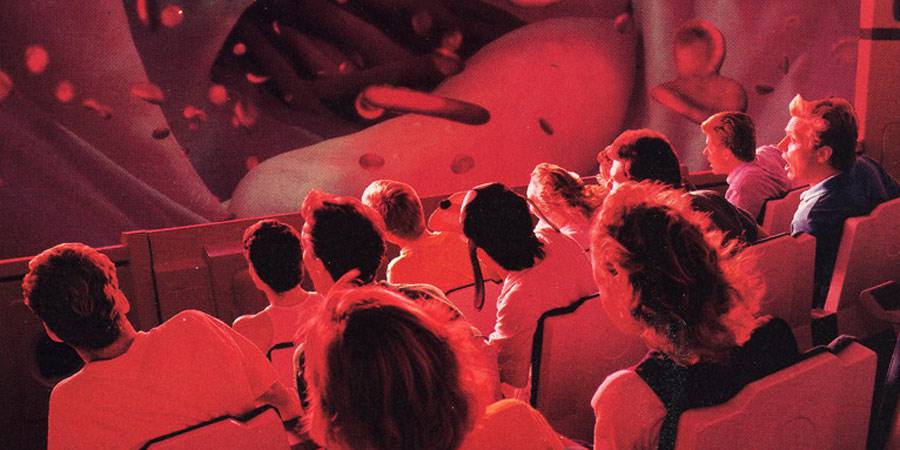 Kris Van de Sande
Kris Van de Sande The transcript for Body Wars, Star Tours’ sister attraction. Newly revised for 2007!
Overview:
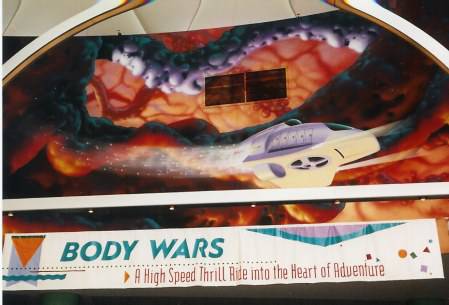
Body Wars was produced by Thomas H. Brodek, from a script written by Scott Hennesy. It was directed by Leonard Nimoy (yes, *that* Leonard Nimoy) and not surprisingly often has a Star Trek kind of feel, especially in the sets and costumes for Mission Control, as well as the ‘beaming’ technology. Nimoy took time out from post-production of the project to appear in the parade on the opening day of the Disney-MGM Studios, April 30th, 1989. Other celebrities in the parade included Rick Moranis and George Lucas.
Body Wars starred the Oscar-nominated Elisabeth Shue as Dr. Cynthia Lair, while Captain Braddock was played by Tim Matheson, who (as I was recently surprised to learn) began his career as a child actor, most notably voicing classic Hanna-Barbera cartoon characters like Jonny Quest or Jace on Space Ghost. The Mission Control officer in Body Wars was played by veteran actor Dakin Matthews, who would later play Admiral Patterson on Star Trek: Voyager, as well as provide voiceovers for A Goofy Movie.
The ride opened in Epcot on October 19th, 1989 as part of the Wonders of Life pavilion. It was sponsored by MetLife, which inspired the name of the facade for the queue area: Miniaturized Exploration Technologies (or MET for short.) The ride closed in January of 2007.
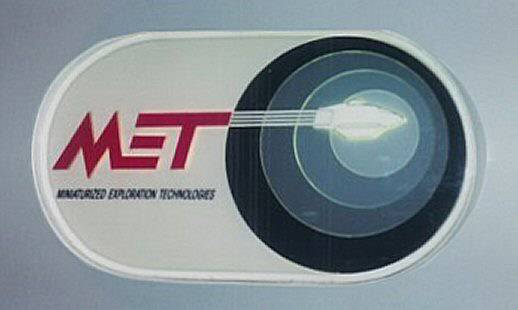
The concept of Body Wars shares many similarities with Star Tours due to their simulator nature, and yet also harkens back to the ‘shrinking the guests’ subject matter of Adventure Thru Inner Space, the ride in Anaheim which Star Tours replaced.
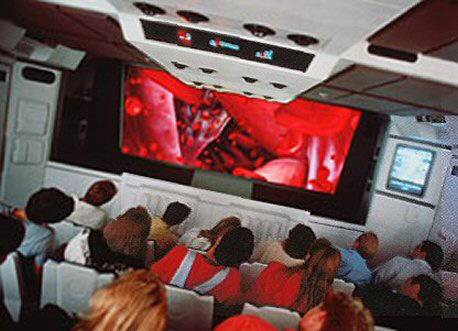
But rather than being injected into a snowflake, like the Atommobile riders of ATIS, the destination for the ride vehicles of Body Wars was arguably influenced by the 1987 Joe Dante film InnerSpace, which was in turn influenced by the 1966 film Fantastic Voyage.
The basic plot is that the simulator is a ‘body probe’ which will be shrunk down to the size of a pinpoint and inserted into a human test subject, to examine the immune system’s response to a splinter in the finger.
But just as with Star Tours, unforeseen circumstances– in this case a rescue mission of fellow shrunken colleague Dr. Lair– cause the ride to take the audience to unexpected places (including the heart, lungs, and brain) before returning the guests safely to their point of origin.
By all accounts, the ride on Body Wars was much more intense than Star Tours. One particularly nauseating effect had the ship surging forwards and back in the alternating air currents while it was in the lungs of the human test subject.
[Even though I have no corroboration, I’m fairly certain that the ‘giant breathing’ sound effect was voiced by the super-talented Frank Welker, who coincidentally did the ‘Spock screams’ for 1984’s Nimoy-directed Star Trek III: the Search for Spock.]
Although it is not known when the change occurred, the lung sequence was undeniably trimmed down, removing four lines of dialogue and leaving a telltale crossfade edit in a film originally intended to be a seamless POV experience.
One theory on why Body Wars was toned down involves a tragic incident from 1995 when a young girl died shortly after collapsing while riding Body Wars. For more information on the fatality, follow this link: http://www.snopes.com/disney/parks/bodywars.htm
Reports indicate that the girl collapsed three minutes into the ride. The splice which excises part of the lung sequence occurs approximately two and a half minutes into the ride, so it’s possible she would have already experienced the back and forth motion of the simulator, timed to the now-edited whooshing breaths, just before her collapse. However, this is merely speculation on my part; at this time, it is unclear whether the ‘lung edit’ was made before or after this sad event in 1995.
[New evidence from Disney theme park documentarian Martin Smith of the United Kingdom suggests that the ‘lung edit’ occurred prior to the fatality, sometime between 1990 and 1992.]
One other edit, possibly made at the same time, excised a line of dialogue by Mission Control which paralleled Red Leader’s “This is a combat zone. It’s restricted!” comment from Star Tours. In the original version, the Mission Control officer warns Captain Braddock that the capillary/vein which body probe Bravo Two Two Niner has just entered is “an unauthorized area.” This was possibly taken out so that Mission Control’s comments seemed more supportive and never critical.
The transcript which follows was made from the complete original audio; a description of the revisions will appear at the end. A home movie of the edited version of the ride has been posted to YouTube under the title “A History of Body Wars”. The crossfade edit is quite obvious where the lung sequence was shortened.
Oh, and I did my best to double-check all of the anatomical terms used in the dialogue, but it’s possible that some of them are still not 100% accurate. I will vouch for the ‘spinal dura mater’ though. Until a couple of days ago, I’d never heard the term ‘dura mater’ (Latin for “tough mother” or “hard mother”), which I now know to be the toughest layer of the meninges which protect the spinal column.
You can tell just how Disney-influenced my current thinking is, because until I researched this medical terminology, every time I heard them say ‘mater’ in the Body Wars audio tracks, I kept thinking “You know, like Tuh Mater. Without the Tuh.”
Enjoy!
AN
————————————————————————————————
Queue Area:
Female Controller: Attention all observation team members. Before entering a body probe vehicle, you must pass through a level one and level two dermatopic purification screen. Thank you.
Female Controller #2: Body probe Zulu One Seven Four is ready for boarding in bay number one. Will the scheduled spinal dura mater observation team please report to the boarding area?
Male Controller: Body probe Sierra Six Five Seven is online for miniaturization in bay three. Condition: code green.
Female Controller: Will a molecular compression specialist please report to bay two? Repeat, will a molecular compression specialist please report to bay number two?
Jane: Hello, everyone, my name is Jane and I’m your orientation officer. My job is to familiarize you with the process of miniaturization. You’ll be travelling in our ultra-comfortable LGS 250 body probe vehicle. This ship is one of the newest in our fleet and weighs approximately 26 tons. By way of a highly sophisticated and ingenious process, not only will your ship be miniaturized, it will be beamed below the skin of a volunteer so that you will be able to view the inner workings of the human body. During this time, the ship will remain much smaller than the point of a pin and weigh less than a drop of water. When your mission is over, the ship will be returned to full size, at the same exact coordinates from which it was miniaturized. In the late 20th century, NASA began its exploration of space using unmanned vehicles. In time, the space program became sophisticated enough to send men to the moon. Our program began in much the same way. Unmanned vehicles led the way, and today we have a fleet of four body probe shuttles[**] sending miniaturized medical teams into the body on a daily basis. From all of us here at the center, congratulations on becoming part of our miniaturization program. We’re sure that you’ll be amazed by your mission into the body, and we hope that you enjoy and learn from your journey today.
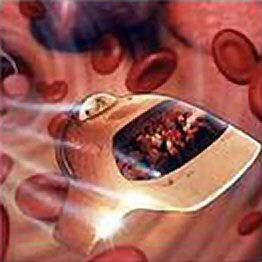
**[Jane says there are four LGS 250’s in the body probe shuttle fleet, yet if you pay close attention to the audio, you will hear call signs for a total of five: Z174, S657, B229, F817, and C218.]
****
Queue 2:
Male Controller: Scott Carey. Scott Carey, please report to the de-miniaturization briefing room.
Female Controller: Will Dr. Humphrey, Dr. Victoria Humphrey, please pick up the epidermal cell scanner from bay number three? Thank you.
Male Controller: Body probe Bravo Two Two Niner has been rolled to the loading area in bay number two. Final clearance inspection now underway. Condition: code yellow.
Female Controller: Bay number three reports successful de-miniaturization of probe Foxtrot Eight One Seven.
Female Controller #2: Attention, we have miniaturization of probe Zulu One Seven Four taking place in bay one. Zulu One Seven Four has been miniaturized and has entered the spinal dura mater.
Dr. Fletcher: Oh, hello. I’m Dr. Fletcher and I’m the chief scientist here at the miniaturization center. Now, I’m sure you’re all aware that our health is constantly being challenged by viruses, bacteria, and various other microorganisms. Here, you see the body’s white blood cells being mobilized to attack invading bacteria. With miniaturization, it is now possible to go into the body aboard vehicles like this, and actually witness immune system activities firsthand. Now, we do this for two reasons. One, by directly observing the immune system, we are gaining valuable knowledge in the war against disease. Two, we are now able to perform once-impossible operations from inside the body. So as not to endanger our civilian observers, you’ll be assigned to a routine mission in the subskin region, a relatively safe area in the body. Don’t worry, there will be plenty for you to see.
[Dr. Fletcher is a distinguished-looking dark-skinned gentleman, with a receding hairline and a beard. This researcher would pay real money for the desktop model of a body probe which he has as a prop in this short scene.]
*****
Preshow:
Male Controller: Attention. Miniaturization of probe Sierra Six Five Seven now commencing in bay three. [sound effect] We have miniaturization and successful entry into the occipital frontalis muscle.
Female Controller: Attention. All personnel planning to explore the tympanic membrane, please report to briefing room One One Seven.
Female Controller #2: Particle reduction technician Harris, that’s particle reduction technician Harris, please contact bay number one.
Female Controller: Attention. Bay four announces final clearance check for probe Charlie Two One Eight. Passenger loading now underway.
Mission Control: Hello, everyone, I’m your Mission Control officer. Around me you see just a small part of the enormous team that is required to bring about a successful miniaturization. While every mission has its special challenges, this group is dedicated to making each voyage a safe and productive one. As your Control officer, my duties are vital to the success of your mission. This state-of-the-art equipment enables me to supply your captain with essential navigational information, and to monitor the status of the onboard power and life-support systems. I’ll stay in contact with your ship at all times. [sound effect] I’m getting a signal that, uh, bay number four is ready for a miniaturization. At this time, I’m going to switch your picture over to bay four [sound effect] so that we can all watch another probe like yours being miniaturized. This is one of our body probes. Onboard is the pilot and another group of civilians on a mission similar to yours. This is one of our volunteers. A few days ago, he bruised his arm in a fall. This particular probe will be going just below the skin to the site of that bruise, so that its crew can study how the damaged cells are repairing themselves. The subject has been thoroughly prepped and tested. Of course, he will feel nothing during the mission because the probe entering his arm is approximately the size of a single human cell.
[The Mission Control environment bears a certain resemblance to the bridge of the Enterprise D from Star Trek: The Next Generation, a television show on which Nimoy would reprise his “Spock” character in 1991. The red costume of the Mission Control officer is very in keeping with the dress uniforms of Starfleet command officers. When the officer mentions ‘state-of-the-art’ monitoring equipment, he is referring to a lifesize acrylic tabletop replica of the human body, very similar to the old ‘Visible Man’ model kits, if it were reclining instead of standing erect.]
Female Medtech: Are you comfortable?
Med One: Med One reports ready to commence miniaturization procedure.
Mission Control: Roger, Med One. Charlie Two One Eight, this is Control, are you ready to go?
Female Pilot: (Southern accent) That’s Charlie Two One Eight, all systems go.
Mission Control: The particle reducer is being lowered into position now.
Med One: Cellular compression unit engaged.
Mission Control: Three… two… one… [sound effect]
Female Pilot: (Southern accent) Charlie Two One Eight, safe inside, headin’ for the bruise area.
Mission Control: Roger, Charlie Two One Eight. All systems operating. We’ve just received confirmation that probe and crew have penetrated the subcutaneous epidermal tier. We are now… under the skin. [sound effect] Ladies and gentlemen, your probe Bravo Two Two Niner is being prepared. I’ll be seeing you before you board with some specifics about your mission.
******
The following text could be seen on the monitor in between video segments while waiting to board. Note that this is the only time we learn the destination of body probe Sierra Six Five Seven:
BOARDING INFORMATION
BAY PROBE DESTINATION MIN. TO LAUNCH
1 Z174 Spinal Dura Mater Departed
2 B229 Epidermal Tier/Splinter 04:52
3 S657 Spongy Medulla/Tibia 51:53
4 C218 Epidermal Tier/Bruise Departed
******
Preshow 2:
Mission Control: You have now reached your body probe boarding area. As your Control officer, I’d like to give you some important information about your mission. This is Dr. Cynthia Lair, one of our foremost immunologists.
[A graphic of Dr. Lair appears on the monitor, reminiscent of an ID badge. Elisabeth Shue appears for the first time as a still photo, looking straight ahead at the camera. Her identifying information appears as text alongside:
DR. LAIR, CYNTHIA IMMUNOLOGY KO668483 SECURITY AA ]
Mission Control: (continued) Ten minutes ago, she was miniaturized and beamed to the site of a splinter in the right index finger of a volunteer. Her objective is to conduct tests on the immune system’s response to that splinter. You will be onboard body probe Bravo Two Two Niner. Your mission will take you to the location of that splinter. Once there, your probe will rendezvous with Dr. Lair, and bring her out. I’m attempting to contact Dr. Lair right now, we’ll see if we can get a report on how her experiment is proceeding. Dr. Lair, this is Mission Control, your recovery team is with me. Can you tell us how your experiment has been going?
Dr. Lair: Fantastic! The mission has been a complete success.
Mission Control: Can you give our observers a brief description of your objectives?
Dr. Lair: Sure. I’m here to study the inflammatory response of the neutrophils as they react to invading bacteria.
Mission Control: In layman’s terms, please, Dr. Lair.
Dr. Lair: Simply speaking, I’m here to observe the speed and effectiveness of the white blood cells as they rush to protect the body from infection.
Mission Control: Thank you, Dr. Lair. Bravo Two Two Niner will be on its way shortly to pick you up.
Dr. Lair: See you soon.
Mission Control: I’d now like to introduce you to your pilot, a person who has been with this program since its inception. Captain, are you ready?
Captain Braddock: Hello everyone, I’m Captain Braddock. I’m glad you’ll be joining me aboard Bravo Two Two Niner.
Mission Control: Captain, how are your pre-launch preparations going?
Captain Braddock: I am almost cleared for launch here, Control, let’s see … field reverse is on. Check. Life support systems activated. Check. Fuel cells, full and functioning. Check. Folks, I need to make one final radio check with Dr. Lair; we’re just about set to go. [sound fx] Hello, Dr. Lair, this is Captain Braddock aboard Bravo Two Two Niner. How’s the weather in there?
Dr. Lair: Clear and warm, Captain. About 98.6. Actually, it’s a little warmer by the infection site.
Captain Braddock: Very good. Over. Well, friends, we’re about ready for launch. But before you board, I’m going to give you back to Mission Control so you can get some final instructions.
Mission Control: At this time, we ask that you please pay attention to this important boarding information. When the probe doors have opened, please proceed directly into the vehicle, and all the way across your aisle, filling in every available seat. For your protection, all observation team members are required to wear safety restraints throughout the mission. To fasten the restraint, pull the strap out from the right side of the seat, and snap it into the buckle on your left. Mission Control specifies that all carry-on items be safely stowed beneath your seat. To maintain the required cleanliness for a mission of this kind, smoking is prohibited. And while onboard, we ask that you refrain from using flash photography. Your vehicle, Bravo Two Two Niner, is now ready. Please begin immediate boarding, and have a safe and informative journey.
[The boarding video depicts an interesting mix of observers in medical attire and theme park tourists, including a boy wearing a Figment hat. When the riders are shown stowing their carry-on items under the seats, the second item depicted looks amazingly like the flashlight/magnifying-glass/bicycle-helmet headgear worn by Dr. Wayne Szalinski (Rick Moranis) in the 1989 movie “Honey, I Shrunk the Kids”… a film which would later be incorporated into EPCOT as Honey, I Shrunk the Audience, in 1994.]
******
Ride Safety:
Female Crew Member: Welcome aboard. We’d like to remind you that all your carry-on items should be safely stowed beneath your seat. And since your body probe vehicle may experience occasional turbulence, make sure that your seatbelt is fastened. Thank you.
Woman at Mission Control: Bravo Two Two Niner, cabin integrity verified. Begin pressurization. [sound effect] Cabin pressurized. I’m switching you to your internal power.
******
Ride:
Captain Braddock: Hello again, everyone. We’ll be getting underway momentarily.
Mission Control: Bravo Two Two Niner, are you ready to initiate launch?
Captain Braddock: That is affirmative, Control. All systems go.
Mission Control: Begin initial reduction sequence.
Captain Braddock: Reduction sequence begun. We’re now approaching the miniaturization room… [sound effect] where the technicians will focus a particle beam on our ship.
Technician: Particle reducer, engaged.
Mission Control: Roger.
Captain Braddock: Entry depth set at 200 microns.
Mission Control: Bravo Two Two Niner, begin reduction mode… now. Three… two… one.
Captain Braddock: Hold on, everybody! [sound effect] Control, this is Bravo Two Two Niner. We’re under the skin. Everything looks fine.
Mission Control: Roger.
Captain Braddock: Folks, directly in front of us is a group of white blood cells on their way to destroy the splinter. There it is now. Sure is a lot of activity out there. Dr. Lair, we’re experiencing some turbulence. I advise you to come aboard immediately.
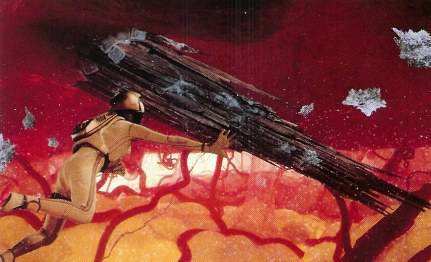
Dr. Lair: In a minute, Captain. I need to take one more cell count.
Captain Braddock: Roger. We’re standing by.
Dr. Lair: We’re gathering a lot of valuable information here. I hope that — Mayday!
Captain Braddock: Dr. Lair, are you okay?
Dr. Lair: Mayday! I’m being pulled into a capillary!
Captain Braddock: Hang on, I’m coming to get you.
Mission Control: Braddock, what’s going on?
Captain Braddock: I’m in a vein. Dr. Lair needs help.
Mission Control: Get her onboard that ship, Captain. You’re in an unauthorized area. [* Also see Revised version, below.]
Dr. Lair: I’m being pulled… toward the heart!
Mission Control: Braddock! Watch your pressure. Your ship could be crushed.
Dr. Lair: I’m in the right ventricle!
Captain Braddock: We’re right behind you. [sound effect] Well, that can’t be good.
Mission Control: Our instruments show you down to half power.
Captain Braddock: I know, we lost a fuel cell! Gotta get out on the next beat.
Mission Control: You’re heading for the lungs, Captain. Air current’s extremely hazardous.
Captain Braddock: I have to chance it.
Dr. Lair: Braddock, if you read me, I’m in the lungs. [* Also see Revised version, below.]
Captain Braddock: I’ve got you in my sight, Doctor.
Mission Control: You’re fuel’s running low. You’re down to quarter power.
Captain Braddock: Doctor, I’ve lost you. Where’d you go?
Dr. Lair: I’m in an air sac, I need some help here. I’m being attacked by a white blood cell.
Captain Braddock: I see you! I’m gonna use the lasers to try and stun it.
Dr. Lair: Hurry! [sound effect]
Captain Braddock: Quick! Into the ship!
Dr. Lair: I’m in.
Captain Braddock: Control, I’ve got Dr. Lair.
Mission Control: Braddock, you’ve used too much power. You can’t beam out.
Captain Braddock: We need an energy boost.
Dr. Lair: The brain. It works on electrical impulse.
Captain Braddock: How do we get there?
Dr. Lair: Through that capillary.
Mission Control: We’re tracking you to the heart again!
Dr. Lair: It’s our only choice.
Captain Braddock: The current is too strong. The rudders won’t respond. Alright, I’ve got it now.
Dr. Lair: Okay, we’re in the heart’s left atrium.
Mission Control: Braddock, your power is decreased to five percent. Repeat, five percent.
Captain Braddock: I’m gonna use the heartbeat to propel us. You ready? Now!
Dr. Lair: Turn! To the right! Oh! Okay, we’re in the cerebral artery. It’s taking us to the brain. We’re just above the brain, in the spinal fluid. [sound effect]
Mission Control: Your power is down to two percent. If you can get power, I can beam you out of there.
Captain Braddock: We’re gonna need some electricity, fast.
Dr. Lair: We’re gonna have to cross the blood-brain barrier. Can you get us inside?
Captain Braddock: It’s gonna take all the power we have left. Here we go.
Dr. Lair: The cerebral cortex! We’re inside the brain.
Captain Braddock: I’m gonna deploy the fuel cell shield, and hope it works like a lightning rod.
Mission Control: Braddock, your power is gone. We can’t get you out. Repeat, your power is gone.
Dr. Lair: This neuron better fire. [sound effect]
Captain Braddock: Come on, hit the shield. Hit the shield!
Mission Control: You have power!
Dr. Lair: We did it!
Mission Control: We’re beaming you out.
Dr. Lair: Incredible! Do you realize what we just did?
Mission Control: I’ll tell you what you did. You broke every regulation in the book.
Dr. Lair: Control, we were the first to go through the heart, lungs, and brain.
Mission Control: You also managed to pull off the most spectacular mission this place has ever seen. Congratulations.
[applause from Mission Control crew ]
Captain Braddock: Thank you, Control. Uh, folks, you can unlatch your safety belt by pushing the button on your left. Please exit the ship to your right, don’t forget your personal belongings. Oh, and… welcome home.
*******
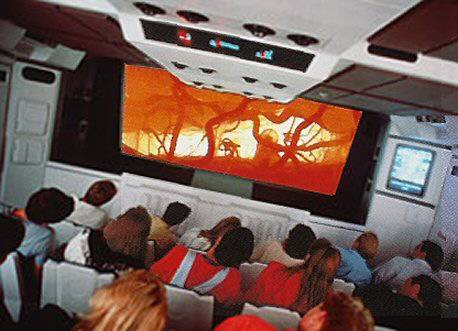
*Revised version:
Captain Braddock: I’m in a vein. Dr. Lair needs help.
Mission Control: Get her onboard that ship, Captain. [the line about unauthorized areas is removed in this later version]
Dr. Lair: I’m being pulled… toward the heart!
Mission Control: Braddock! Watch your pressure. Your ship could be crushed.
Dr. Lair: I’m in the right ventricle!
Captain Braddock: We’re right behind you. [sound effect] Well, that can’t be good.
Mission Control: Our instruments show you down to half power.
Captain Braddock: I know, we lost a fuel cell! Gotta get out on the next beat.
Mission Control: You’re heading for the lungs, Captain. Air current’s extremely hazardous.
Captain Braddock: I have to chance it.
Dr. Lair: Braddock, if you read me, I’m in the lungs.
[the film is spliced here with a quick crossfade, losing four lines of dialogue, while the following lines are slightly reordered from their original version]
Captain Braddock: I see you!
Dr. Lair: I’m being attacked by a white blood cell.
Captain Braddock: I’m gonna use the lasers to try and stun it.
******
Transcript by Alex Newborn
Big thanks to Patrick Hurd at WindowtotheMagic.com for help with obtaining the audio files, to Martin Smith for his wonderful documentary film, and to Mouseketeer Alison of Walt Dated World/ for providing the photos!